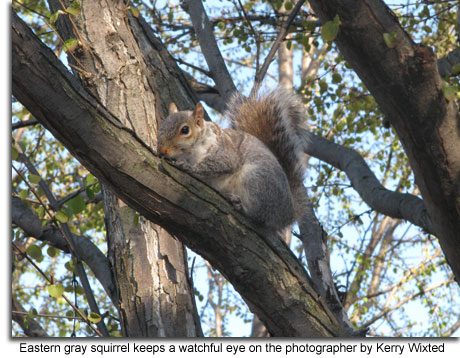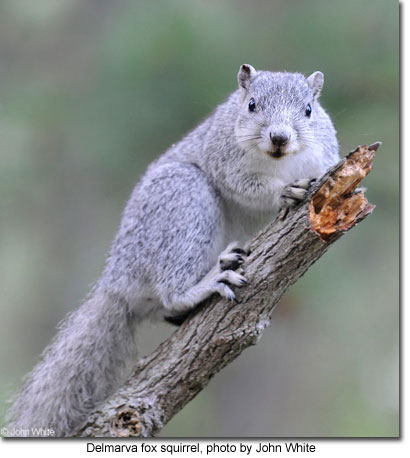Five species of squirrels can be found in Maryland: red squirrel,
gray squirrel,
southern flying squirrel,
eastern fox squirrel and the
Delmarva fox squirrel. All but the Delmarva fox squirrel are common species found throughout most of Maryland.
Red squirrels, also called pine squirrels, are red. These squirrels are less common and smaller than gray squirrels. Red squirrels prefer evergreen trees and mainly live in Western Maryland. Red squirrels eat a variety of foods and are even known to tap sugar maple trees to feed on the sugary sap. Red squirrels are highly territorial and will not let other squirrels, even of different species, into their habitat. To attract red squirrels, plant a variety of evergreens on your property, especially pines and spruces. Red squirrels nest in tree cavities and in ground dwellings and bear 1-2 litters of young each year.

One of the most common squirrels in Maryland is the gray squirrel, which lives almost anywhere that it can find open woodlands (especially oak and hickory forests). Most gray squirrels are just as their name sounds- gray. The color is good camouflage and protects them from predators in the woods. However, some gray squirrels are black, white or blonde. Gray squirrels have large, bushy tails which serve many functions from balance to shade to a rudder when swimming. The trees most commonly used by gray squirrels are white oak, American beech, American elm, red maple and sweetgum. The diet of gray squirrels typically includes acorns, hickory nuts, walnuts, beechnuts, maple (buds, bark, and samaras), tulip poplar blossoms, American hornbeam seeds, apples, fungi, black cherry, flowering dogwood, grapes, sedges, grasses and American holly. Occasionally, gray squirrels will also eat insects (adults and larvae), baby birds, bird eggs and amphibians. Gray squirrels mate in the winter and late summer then build nests in trees. Typically, they have 2 litters per year. To learn more about gray squirrels, then visit the
Gray Squirrel Fact Sheet.

Southern flying squirrels are very common in Maryland but are rarely seen because they are nocturnal. They live in hardwood forests and can often be heard calling in the middle the night. Flying squirrels, despite their name, cannot fly but they can glide from tree to tree using extra folds of skin between their front and hind legs. Southern flying squirrels eat a variety of nuts, acorns and seeds as well as lichen and fungi. Southern flying squirrels nest in tree cavities and typically produce 2 litters per year.

There are two species of fox squirrels native to Maryland. Fox squirrels are stockier and heavier than their more acrobatic cousins and spend more time on the ground. The eastern fox squirrel is very common and is found throughout the piedmont and western regions of Maryland. Like other squirrels, they nest in tree cavities or build nests out of leaves. Eastern fox squirrels are attracted to white oak acorns, American beech nuts and hickory nuts. Eastern fox squirrels breed in December and have 1-2 litters of young per year.
In contrast, the Delmarva fox squirrel is only found on the Eastern Shore. In December 2015, this species was officially removed from the list of Threatened and Endangered Wildlife under the Endangered Species Act by the U.S. Fish and Wildlife Service. This removal was due to concerted conservation efforts by Maryland biologists, states, landowners and others working with the U.S. Fish and Wildlife Service. At one time Delmarva fox squirrels could be found throughout the Delmarva Peninsula and up into Pennsylvania, but habitat loss and timber harvest have severely reduced their range. Delmarva fox squirrels prefer mature forests comprised of both hardwood and pine trees with minimal understory and ground cover. Delmarva fox squirrels feed mostly on oak, hickory, sweetgum, walnut and loblolly pine.
Click here for more information on Delmarva fox squirrels.

Squirrels can be fun to watch. Avid squirrel watchers erect
mazes and obstacle courses with food as a reward at the
end. It is amazing how quickly the squirrels figure out how
to get the food. Squirrels also like nest boxes for both
sheltering young and for protection.
Attracting Squirrels while Reducing Potential Conflicts
Squirrels will eat almost anything: nuts, fruits, seeds, fungi, insects, plant buds, flower parts, bark, roots, and even people food. A variety of trees and food are essential for good squirrel habitat.
Attracting squirrels can be as simple as erecting feeders and nest boxes. However, planting trees that produce nuts can supply natural nest sites as well as food. Squirrels do not necessarily need an open water source. They receive most of their water from dew and the plant material they eat.
A word of warning, though! Having squirrels around means you must secure any possible entrances to your attic. Squirrels like to use attic insulation for nesting material and may even take up residence there. Scattering mothballs will discourage them, but the best solution is eliminating any way they may enter the attic. Squirrels also like plant bulbs.
Planting daffodils among your bulbs will sometimes keep them from dining on the bulbs in your gardens. Liberally applying blood meal and dried red pepper seeds to your flowerbed may also help keep squirrels out. Squirrels are also notorious for raiding bird feeders and can consume large amounts of corn and other nuts and seeds. Providing additional feeders for the squirrels may distract them from the bird feeders. Sheet metal can be placed around the base of the feeder. However, squirrels are quite ingenious at thwarting all attempts to keep them away. Also see:
Living With Squirrels
Tips for Nest Boxes
- Use treated wood or cedar to prevent the box from rotting.
- Don't paint the box and hang the box 10 + feet above the ground on the trunk of a tree.
- The entrance hole should be 3" x 3".
- A 4-inch long piece of 2" x 2" can be nailed horizontally inside the nest boxes to give the squirrels a perch to stand on to peer out the opening.
- Nest boxes should be placed 10 to 15 feet above the ground and on trees at least 10" in diameter.
- You can place 2 or more nest boxes per acre.
- To make the nest box enticing, fill it half full of dry leaves.
- Nest boxes should be set out in the fall since they are heavily used during the winter.
- The entrance should be facing either east or south.
- It is not necessary to clean the nest boxes.
Squirrel Nest Box Plans
Invite Wildlife to Your Backyard!
For more information, please contact:
Maryland Department of Natural Resources
Wildlife and Heritage Service
Tawes State Office Building, E-1
Annapolis MD 21401
410-260-8540
Toll-free in Maryland: 1-877-620-8DNR
[email protected]
Acknowledgements:
- Red squirrel grabs a snack, photo by Kerry Wixted
- Eastern gray squirrel keeps a watchful eye on the photographer by Kerry Wixted
- Southern flying squirrel, photo by J.P. Meyers
- Delmarva fox squirrel, photo by John White